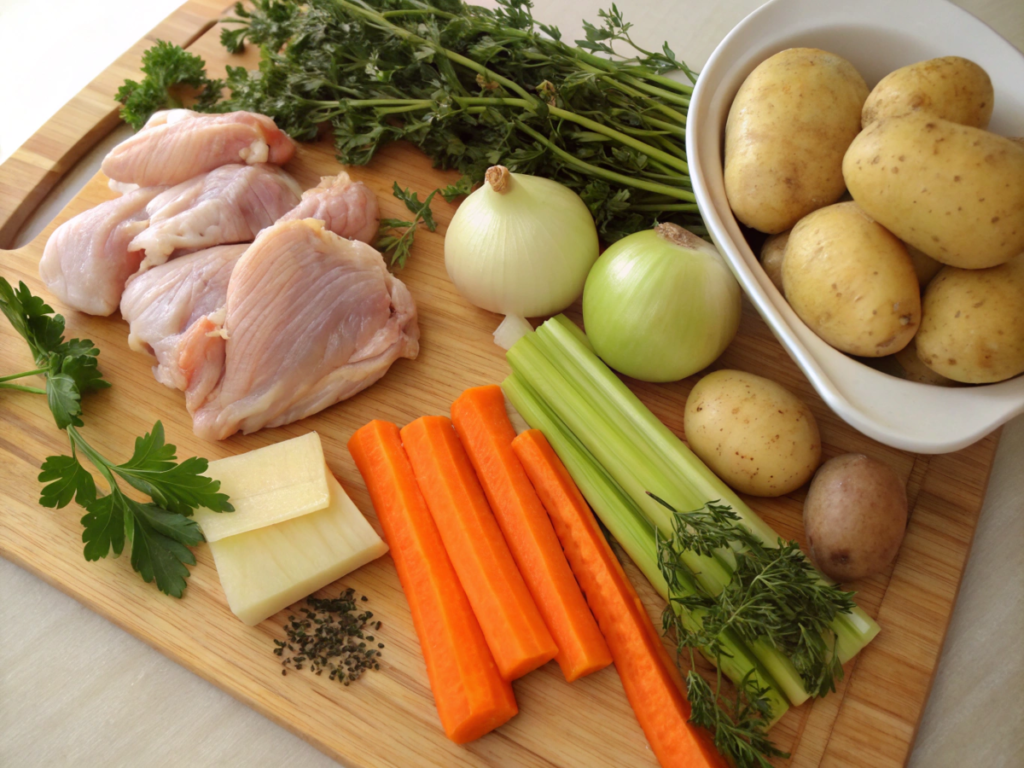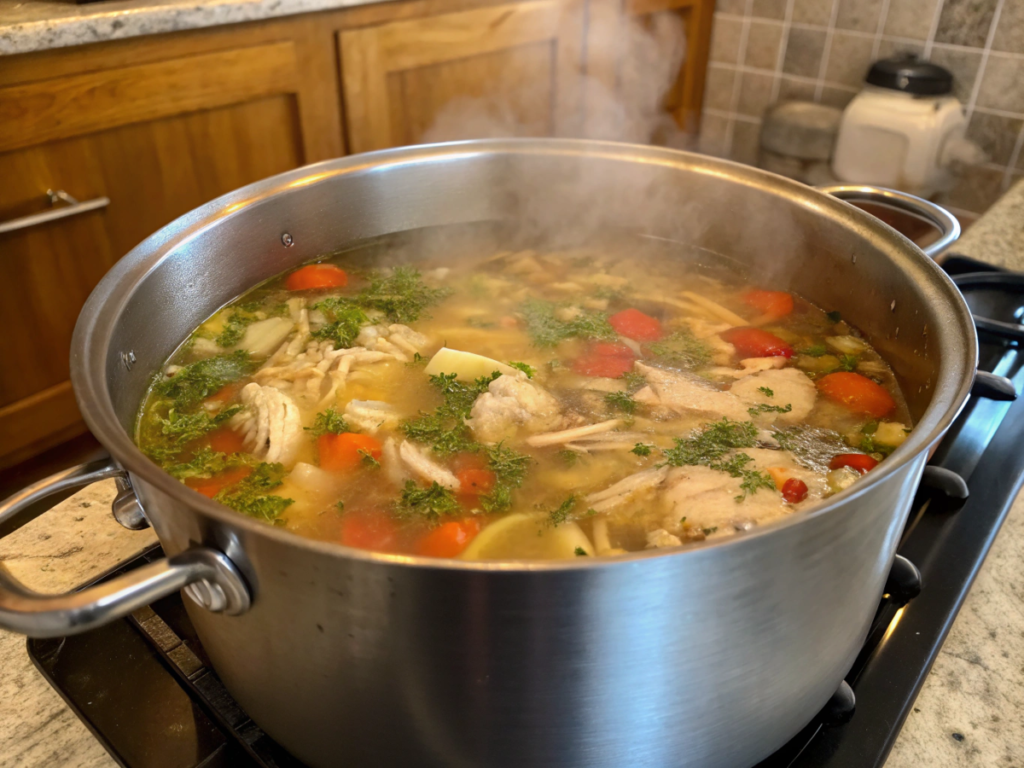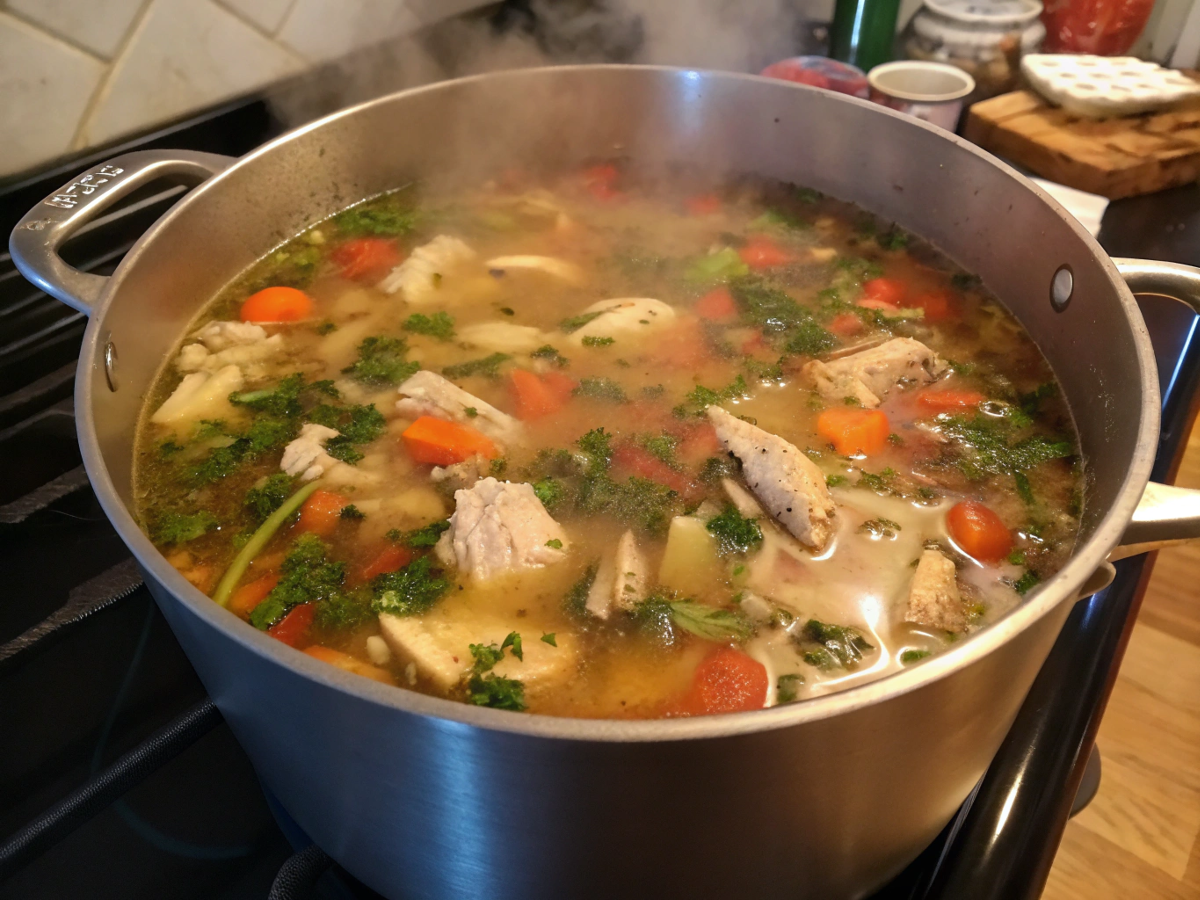Introduction
There’s something incredibly comforting about a warm bowl of homemade chicken soup. Whether it’s a chilly winter evening or you’re feeling under the weather, this classic dish has a way of making everything better. It’s like a warm hug in a bowl—filling, soothing, and packed with flavor.
In this article, we’ll walk you through the entire process of making your own delicious chicken soup from scratch. We’ll cover everything from selecting the best ingredients to perfecting the cooking process, and even explore some tasty variations. By the end, you’ll have all the tips and tricks you need to create a soup that’s not only nourishing but also bursting with flavor.
So, grab your apron, dust off your stockpot, and let’s get started on this culinary adventure! Whether you’re a seasoned cook or a beginner, making homemade chicken soup is easier than you think—and the results are absolutely worth it.
Part 1: Ingredients
Essential Ingredients for Chicken Soup

To make a delicious homemade chicken soup, you’ll need a few key ingredients. Here’s what you’ll need:
- Chicken: A whole chicken or bone-in pieces like thighs and drumsticks work best for a rich, flavorful broth. The bones add depth and richness that boneless cuts just can’t match.
- Vegetables: Carrots, celery, and onions are the classic trio, often called the “holy trinity” of soup-making. You can also add garlic, leeks, and parsnips for extra flavor and complexity.
- Broth: Homemade chicken broth is ideal, but store-bought works in a pinch. If you’re using store-bought, opt for low-sodium versions so you can control the saltiness.
- Herbs and Spices: Fresh parsley, thyme, and bay leaves are essential for that aromatic, savory flavor. Don’t forget salt and pepper to taste—they’re simple but crucial for balancing the flavors.
Optional Ingredients for Added Flavor
If you want to take your homemade chicken soup to the next level, consider adding these optional ingredients:
- Noodles or Rice: Add cooked noodles or rice to make the soup heartier. Egg noodles, wild rice, or even orzo work beautifully. They soak up the broth and add a satisfying texture.
- Lemon Juice: A splash of lemon juice brightens up the flavors and adds a refreshing zing. It’s a small addition that makes a big difference, especially if your soup feels a little heavy.
- Ginger: Fresh ginger adds a subtle warmth and depth of flavor, perfect for a cozy twist. It’s especially great if you’re feeling under the weather, as it has natural soothing properties.
- Mushrooms: Sliced mushrooms add an earthy richness to the soup, making it feel even more luxurious. Try cremini or shiitake mushrooms for extra depth and a gourmet touch.
Tips for Selecting the Best Ingredients
- Chicken: Opt for organic or free-range chicken for the best flavor and quality. Bone-in, skin-on cuts like thighs or a whole chicken are ideal for a richer broth. The bones and skin add collagen, which gives the soup a silky texture.
- Vegetables: Choose fresh, crisp vegetables for the best texture and taste. Look for firm carrots, bright celery, and onions without soft spots. Fresh veggies not only taste better but also hold up better during cooking.
- Broth: If using store-bought broth, look for low-sodium options to control the saltiness of your soup. Better yet, make your own broth for maximum flavor! Homemade broth is easier than you think and makes a world of difference.
- Herbs: Fresh herbs are always better, but dried herbs can be used in a pinch. Just remember to use less, as dried herbs are more concentrated. For example, 1 teaspoon of dried thyme equals about 1 tablespoon of fresh thyme.
Part 2: Preparation of the chicken Soup.
Prepping the Chicken

Before we start cooking, it’s important to properly prep the chicken. Here’s how:
- Clean the Chicken: Rinse the chicken under cold water and pat it dry with paper towels. This helps remove any impurities and ensures a clean base for your soup.
- Remove Excess Fat: Trim any excess fat from the chicken pieces to avoid a greasy soup. A little fat is fine—it adds flavor—but too much can make the broth oily.
- Cut into Pieces: If using a whole chicken, cut it into manageable pieces like thighs, drumsticks, and breasts. This makes it easier to cook evenly and shred later.
Chopping Vegetables
Next, let’s get our vegetables ready:
- Carrots: Peel and slice the carrots into thin rounds or small chunks. This ensures they cook evenly and add a nice texture to the soup.
- Celery: Wash and chop the celery into small pieces. Celery adds a subtle crunch and a fresh, earthy flavor.
- Onions: Peel and dice the onions into small, even pieces. Onions are the flavor foundation of your soup, so don’t skimp on them!
- Garlic: Mince the garlic cloves for added flavor. Garlic brings a rich, aromatic depth that ties everything together.
Preparing the Broth
A good broth is the heart of any homemade chicken soup. Here’s how to prepare it:
Homemade Broth
If you’re making your own broth, start by simmering the chicken bones with water, onions, carrots, celery, and herbs for a few hours. Here’s a step-by-step guide:
- Add Ingredients to the Pot: Place the chicken bones (or a whole chicken) in a large stockpot. Add roughly chopped onions, carrots, celery, and a handful of fresh herbs like parsley, thyme, and bay leaves.
- Cover with Water: Pour in enough water to cover the ingredients by about an inch.
- Simmer Gently: Bring the mixture to a boil, then reduce the heat to a low simmer. Let it cook for 2-3 hours, skimming off any foam or fat that rises to the top.
- Strain the Broth: Once the broth is rich and flavorful, strain it through a fine-mesh sieve or cheesecloth. Discard the solids, and you’ll be left with a golden, aromatic broth that’s perfect for your soup.
Store-Bought Broth
If you’re short on time, store-bought broth works just fine. Here’s how to make it taste almost as good as homemade:
- Choose Low-Sodium Broth: Opt for a low-sodium version so you can control the saltiness of your soup.
- Enhance the Flavor: Pour the broth into a pot and add fresh veggies (like onions, carrots, and celery) and herbs (like parsley, thyme, and bay leaves).
- Simmer for Depth: Let the broth simmer with the added ingredients for about 20-30 minutes. This infuses it with extra flavor and makes it taste richer.
Part 3: Cooking Process of Chicken Soup

Step-by-Step Cooking Instructions
- Sauté the Vegetables: In a large pot, heat some oil over medium heat. Add the onions, carrots, and celery, and sauté until they start to soften, about 5-7 minutes.
- Add the Chicken: Place the chicken pieces into the pot, ensuring they are evenly distributed among the vegetables.
- Pour in the Broth: Pour in enough broth to cover the chicken and vegetables. If you’re using homemade broth, this is the time to add it.
- Add Herbs and Spices: Toss in the fresh parsley, thyme, and bay leaves. Season with salt and pepper to taste.
- Bring to a Boil: Increase the heat to high and bring the mixture to a boil. Once boiling, reduce the heat to low and let it simmer.
- Simmer: Allow the soup to simmer for about 1-1.5 hours, or until the chicken is cooked through and the flavors have melded together.
- Remove the Chicken: Carefully remove the chicken pieces from the pot and set them aside to cool slightly.
- Shred the Chicken: Once the chicken is cool enough to handle, shred the meat using two forks, discarding the bones and skin.
- Return the Chicken to the Pot: Add the shredded chicken back into the pot and stir to combine.
- Adjust Seasoning: Taste the soup and adjust the seasoning as needed. Add more salt, pepper, or herbs if desired.
Tips for Achieving the Perfect Consistency
- Skim the Fat: As the soup simmers, use a spoon to skim off any excess fat that rises to the surface. This will help keep the soup clear and not too greasy.
- Thicken the Broth: If you prefer a thicker broth, you can add a slurry made from cornstarch and water. Mix 1 tablespoon of cornstarch with 2 tablespoons of water, then stir it into the soup and let it simmer for a few more minutes.
- Add Noodles or Rice: For a heartier soup, add cooked noodles or rice during the last 10-15 minutes of cooking.
Common Mistakes to Avoid
- Overcooking the Chicken: Be careful not to overcook the chicken, as it can become tough and dry. Keep an eye on the cooking time and check for doneness.
- Using Too Much Salt: It’s easy to add too much salt, especially if you’re using store-bought broth. Start with a small amount and adjust as needed.
- Skipping the Skimming: Skimming the fat is an important step for a clear and flavorful broth. Don’t skip it!
Part 4: Variations of the Chicken Soup
Different Types of Chicken Soup
There are countless ways to make homemade chicken soup, each with its own unique twist. Here are a few popular variations:
- Creamy Chicken Soup: Add a splash of heavy cream or milk to create a rich, creamy texture. You can also blend some of the vegetables for a thicker consistency. This version feels indulgent and comforting.
- Spicy Chicken Soup: For a kick of heat, add diced jalapeños, red pepper flakes, or a dash of hot sauce. This variation is perfect for those who love a bit of spice and want to warm up from the inside out.
- Chicken Noodle Soup: A classic favorite, simply add cooked egg noodles or pasta to the soup. This version is especially comforting and filling, making it a go-to for cold days or when you’re feeling under the weather.
Regional Variations
Chicken soup is enjoyed all around the world, and each region has its own take on this beloved dish:
- Matzo Ball Soup: A traditional Jewish soup made with matzo balls, which are dumplings made from matzo meal, eggs, and fat. It’s often served during Passover and is known for its hearty, comforting texture.
- Tom Yum Gai: A Thai version of chicken soup that features a spicy and sour broth made with lemongrass, lime leaves, and chili paste. It’s packed with bold flavors and aromatic herbs, making it a vibrant and refreshing option.
- Avgolemono Soup: A Greek chicken soup that includes a mixture of eggs and lemon juice, which gives the broth a creamy and tangy flavor. It’s often served with rice or orzo and is both rich and refreshing.
Vegetarian and Vegan Alternatives
For those who prefer a plant-based diet, there are plenty of delicious alternatives to traditional chicken soup:
- Vegetable Soup: Replace the chicken with a variety of hearty vegetables like potatoes, beans, and lentils. Use vegetable broth instead of chicken broth for a flavorful base. This version is just as comforting and packed with nutrients.
- Tofu and Mushroom Soup: Substitute chicken with tofu and mushrooms for a protein-packed and savory soup. Add soy sauce and ginger for an extra burst of flavor. This variation is perfect for anyone looking for a meat-free option that’s still rich and satisfying.
Part 5: Serving Suggestions the Chicken Soup

Best Accompaniments for Chicken Soup
A bowl of homemade chicken soup is delicious on its own, but pairing it with the right accompaniments can elevate the meal:
- Crusty Bread: A slice of warm, crusty bread is perfect for dipping into the soup.
- Salad: A light, fresh salad with a tangy vinaigrette complements the rich flavors of the soup.
- Crackers: Classic saltine crackers or buttery Ritz crackers add a satisfying crunch.
Presentation Tips
Making your chicken soup look as good as it tastes is easy with these tips:
- Garnish: Sprinkle some fresh parsley or chives on top for a pop of color and flavor.
- Serve in Bowls: Use deep, wide bowls to showcase the soup and make it easy to enjoy.
- Add a Lemon Wedge: A lemon wedge on the side adds a touch of brightness and allows guests to customize their soup.
Storing and Reheating Leftovers
Homemade chicken soup is great for meal prep and can be stored for later enjoyment:
- Refrigerate: Store the soup in an airtight container in the refrigerator for up to 4 days.
- Freeze: For longer storage, freeze the soup in individual portions. It will keep for up to 3 months.
- Reheat: To reheat, simply warm the soup on the stove over medium heat until it’s hot and bubbling. If the soup has thickened, add a splash of broth or water to reach the desired consistency.
Part 6: Health Benefits
Nutritional Value of Chicken Soup
Homemade chicken soup is not only delicious but also packed with nutrients. Here’s a quick rundown of its nutritional benefits:
- Protein: Chicken is a great source of lean protein, which is essential for muscle repair and growth.
- Vitamins and Minerals: The vegetables in the soup provide a variety of vitamins and minerals, including vitamin A, vitamin C, and potassium.
- Collagen: Slow-cooking the chicken bones releases collagen, which is beneficial for joint health and skin elasticity.
Health Benefits and Healing Properties
Chicken soup has long been touted as a remedy for colds and flu. Here are some reasons why it’s considered a healing food:
- Hydration: The broth helps keep you hydrated, which is crucial when you’re feeling under the weather.
- Anti-Inflammatory: The ingredients in chicken soup, such as garlic and onions, have anti-inflammatory properties that can help reduce symptoms of illness.
- Comfort Food: The warmth and comfort of chicken soup can help soothe a sore throat and provide a sense of well-being.
Scientific Studies Supporting the Benefits
Several studies have explored the health benefits of chicken soup:
- Cold Relief: Research has shown that chicken soup can help alleviate symptoms of the common cold by reducing inflammation in the respiratory tract.
- Immune Support: The nutrients in chicken soup, such as vitamins and minerals, can help support a healthy immune system.
Part 7: FAQs
Common Questions from the ‘People Also Ask’ Section on Google
How long does it take to make homemade chicken soup?
Making homemade chicken soup typically takes about 1.5 to 2 hours, including prep and cooking time. The longer you simmer the soup, the more flavorful it will be. If you’re short on time, using pre-cooked chicken or an Instant Pot can speed things up.
Can I use leftover chicken for chicken soup?
Absolutely! Using leftover chicken is a great way to save time and reduce waste. Just add the cooked chicken towards the end of the cooking process to prevent it from becoming too dry. Rotisserie chicken works especially well for this.
How do I store homemade chicken soup?
Store homemade chicken soup in an airtight container in the refrigerator for up to 4 days. For longer storage, freeze the soup in individual portions for up to 3 months. Make sure to label the containers with the date so you can keep track of freshness.
Can I Make Chicken Soup in a Slow Cooker?
Yes, you can absolutely make homemade chicken soup in a slow cooker! In fact, it’s one of the easiest and most hands-off methods for creating a flavorful, comforting soup. Here’s how to do it:
- Add All Ingredients: Place your chicken (whole or pieces), chopped vegetables (carrots, celery, onions, garlic), herbs (parsley, thyme, bay leaves), and broth into the slow cooker.
- Set the Timer: Cook on low for 6-8 hours or on high for 3-4 hours. The longer cooking time on low allows the flavors to meld together beautifully.
- Shred the Chicken: Once the chicken is cooked through and tender, remove it from the slow cooker. Shred the meat using two forks, discarding any bones or skin.
- Add Final Touches: Return the shredded chicken to the slow cooker. If you’re adding noodles, rice, or other fillers, toss them in and let them cook until tender. Adjust the seasonings with salt, pepper, or a splash of lemon juice.
The slow cooker method is perfect for busy days because it requires minimal effort but delivers maximum flavor. Plus, your kitchen will smell amazing all day long!
What can I add to chicken soup for extra flavor?
To enhance the flavor of your homemade chicken soup, consider adding fresh herbs like parsley or thyme, a splash of lemon juice, or a pinch of red pepper flakes for a bit of heat. You can also experiment with ginger, garlic, or even a dash of soy sauce for an umami boost.
Part 8: Conclusion
In conclusion, making homemade chicken soup is a rewarding and comforting experience. From selecting the freshest ingredients to perfecting the cooking process, this guide has covered everything you need to know to create a delicious and nourishing soup. Whether you stick to the classic recipe or experiment with variations, the result will always be a bowl of warmth and goodness.
So, roll up your sleeves, gather your ingredients, and enjoy the process of making your very own homemade chicken soup. It’s a dish that’s as fun to make as it is to eat. Happy cooking!

